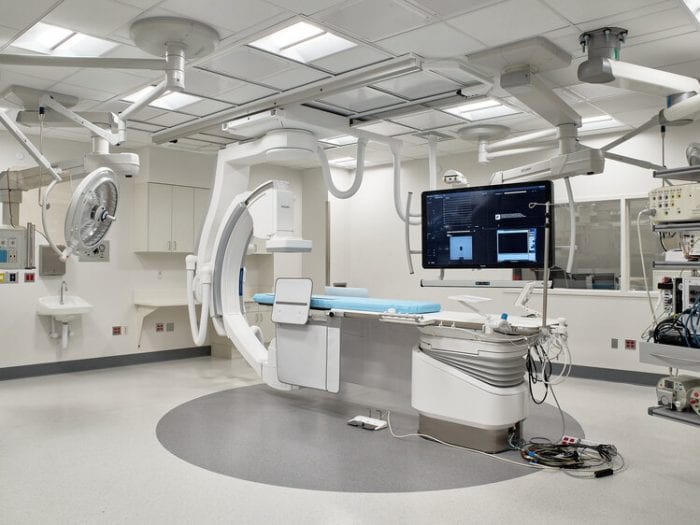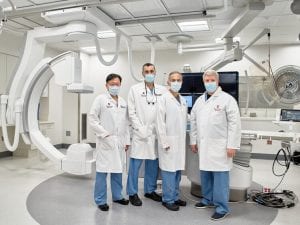Summer is often a time to enjoy the beach, barbecue or to simply catch up on outdoor chores. But with increased activity and heat, the summer sun can also be a trigger for chest pain, or angina. For those who have coronary artery disease, or at risk for developing the disease, those hazy, hot and humid days can be potentially life-threatening. With approximately 9 million patients in the U.S. having symptoms, angina is a serious condition occurring when there is reduced blood flow to the heart and can serve as a precursor to a future heart attack.
Robert Pyo, MD, Director, Interventional Cardiology and Medical Director, Structural Heart, at Stony Brook Heart Institute, offers some tips for protecting your heart during the summer heat.
Your Heart in the Heat
Sweating is one of the ways your body rids itself of excess heat. But as temperatures and humidity climbs, there’s so much water vapor in the air that sweating (evaporation) becomes increasingly difficult and your heart, in trying to cool your body down, winds up working overtime.
Further attempting to shed heat, your body reroutes blood flow from the warmer environment of your internal organs to the cooler surface of your skin, causing your heart to beat faster and pump harder and putting significantly more strain on not just your heart but on your lungs, kidneys and cardiovascular system. The higher the uptick in heat and humidity, the greater the burden on your heart and the greater the risk. In fact, on a hot day your heart may have to circulate two to four times as much blood each minute as it does on a cool day.
Beating the Heat and Protecting Your Heart
Some easy but effective strategies for staying heart-safe this summer:
-
Keep cool. Stay indoors or in the shade as much as possible during peak sun hours of 10 a.m. to 4 p.m. Chilled air is the best way to cope with the heat. Cold compresses applied to your ‘pulse points’ — the areas where your veins are closest to your skin’s surface, including wrists, neck, temples and armpits — can assist in cooling down. Extreme exertion, whether in hot weather or not, can bring on angina.
-
Stay hydrated. Hydration helps the heart to more easily pump blood. Drink water before, during and after going outside in hot weather. Avoid caffeine and alcohol as both of these may increase dehydration. And, be mindful of sports drinks that may contain high amounts of caffeine and/or salt as they have the potential to place stress on the heart.
-
Eat water-rich foods. You get about 20 percent of your water from the foods you eat. A hot weather diet that emphasizes cold soups, salads and fruits can both satisfy hunger and provide extra fluid.
-
Protect your skin. Sunburn affects your body’s ability to cool down and increases dehydration. Wear a wide-brimmed hat, wraparound sunglasses, and lightweight, light-colored, loose-fitting clothing. Apply plenty of broad-spectrum or UVA/UVB protection sunscreen with SPF 30 or higher to all exposed skin 30 minutes before going out. Reapply every couple of hours.
Who’s At Risk for Heat-Induced Chest Pain?
While anyone’s health can be at risk in extreme heat, soaring temperatures and humidity are particularly stressful for those who already have a weakened heart. In addition to individuals with cardiovascular disease, hot weather precautions are especially important if you’re an older adult, are overweight, have a history of high blood pressure, high cholesterol, diabetes, lung or kidney disease or stroke. Medications such as diuretics (water pills), beta blockers, antidepressants, antihistamines and decongestants may also make you more vulnerable to the heat. It is important to talk with your doctor to fully understand your individual risk factors and take precautions.
“If you’re experiencing chest pain symptoms, the Stony Brook Chest Pain Center is where you want to be,” says Dr. Pyo. “Our dedicated heart care specialists and state-of-the-art advances in critical protocols are a powerful combination that can save critical treatment time when it matters most.”
Making Every Minute Count
The key to avoiding damage to your heart, is getting treated as quickly as possible. Angina is often the first symptom of heart disease, but in addition to chest pain, discomfort can also occur in such easy-to-ignore places as your shoulders, arms, neck, jaw, abdomen or back. Angina may even appear to be indigestion.
Although for some people their chest pain symptoms might be ongoing but stable for years, for others, there are no red flags at all — allowing blood flow to eventually become completely blocked and a heart attack to occur out of seemingly nowhere.
Don’t take chances with chest pain. If you or a loved one experience any red flag symptoms, don’t wait; call 9-1-1 and get help.
To see a Stony Brook chest pain specialist, call the Chest Pain Center at Stony Brook Heart Institute at (631) 44-HEART (444-3278).







